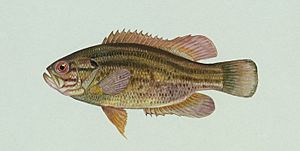Mud sunfish facts for kids
Quick facts for kids Mud sunfish |
|
|---|---|
 |
|
| Conservation status | |
| Scientific classification | |
| Synonyms | |
|
Centrarchus pomotis Baird, 1855 |
The mud sunfish (Acantharchus pomotis) is a cool freshwater fish found along the Atlantic coast of North America. It lives in fresh waters from New York all the way down to Alabama. This fish is special because it's the only species in its group, called Acantharchus. It belongs to the sunfish family, Centrarchidae.
Contents
What Does the Mud Sunfish Look Like?
The mud sunfish is a small fish. It has a body that's a bit flat from side to side and a large mouth and eyes. You can tell it apart from other sunfish by a few things:
- It has five or more spines in its anal fin (the fin on its belly near the tail).
- It has fewer than 15 gill rakers (small bony parts that help it filter food).
- It's the only sunfish with scales called cycloid scales, which are smooth and round.
The fins of the mud sunfish are usually clear or dark olive. Its anal fin has a black edge. It also has a dark spot on its gill cover. The body color changes from brown on its back to yellowish-tan on its sides. Young mud sunfish are a pale olive color. They have 3-4 dark, horizontal stripes that run from their cheek along their body. These fish can grow up to 21 centimetres (8.3 in) long, but they are usually around 14.1 centimetres (5.6 in).
Where Do Mud Sunfish Live?
Mud sunfish live along the eastern coast of the United States. Their range goes from southern New York down to northern Florida. They are also found in a small part of Alabama. There's a gap in their range in parts of Maryland and Virginia. This fish is not very common anywhere it lives.
Mud Sunfish Habitat and Life Cycle
Mud sunfish prefer fresh waters that look dark, like tea, because of natural tannins. They live in slow-moving creeks, rivers, ponds, lakes, and swamps. As their name suggests, they like muddy bottoms or areas with lots of decaying plant material.
These fish are mostly active at night. Scientists haven't studied them a lot because they live in low numbers. However, we know that they lay their eggs (spawn) at different times depending on where they live. In Delaware, they spawn in late spring and early summer. Further south, in North Carolina and Georgia, they spawn in early fall and late winter.
Mud sunfish can live for up to 8 years. They become old enough to reproduce when they are just one year old. Their diet mainly includes small water creatures like amphipods, crabs, and beetles. They also eat some smaller fish and dragonflies.
Protecting the Mud Sunfish
The IUCN (International Union for Conservation of Nature) says the mud sunfish is a species of "Least Concern." This means its overall population is stable. However, in some states, the number of mud sunfish has dropped a lot.
For example, in New York, the fish was last seen in the Hackensack River in 1935. In New Jersey, their numbers have also gone down, especially in the northern and central parts of the state. But they are still quite common in the Pinelands area of New Jersey. The decline in New Jersey might be due to changes in land use and habitat. Also, new fish species that eat mud sunfish have been introduced. Because of this, New Jersey has suggested classifying the mud sunfish as a "species of special concern." Sadly, they are no longer found at all in Pennsylvania.
About the Mud Sunfish Name
The mud sunfish was first officially described in 1855 by Spencer Fullerton Baird. He called it Centrarchus pomotis. The first places where this fish was found and studied were Cedar Swamp Creek in New Jersey and the Hackensack River in New York.
Later, in 1864, Theodore Nicholas Gill decided this fish was unique enough to have its own group. He created the genus Acantharchus. The name Acantharchus comes from two Greek words: acanthus, meaning "thorn," and archus, meaning "anus." This refers to the spines on its anal fin.


